NASA’s Perseverance Captures Video, Audio of Fourth Ingenuity Flight
On April 30, 2021, NASA’s Perseverance rover made history as the first spacecraft to record sounds from another spacecraft on another planet. During Ingenuity’s fourth flight, a microphone included with the SuperCam instrument aboard Perseverance captured the humming sound of the blades and the din of wind. Credit: NASA/JPL-Caltech/ASU/MSSS/LANL/CNES/CNRS/ISAE-SUPAERO

For the first time, a spacecraft on another planet has recorded the sounds of a separate spacecraft. NASA’s Perseverance Mars rover used one of its two microphones to listen as the Ingenuity helicopter flew for the fourth time on April 30, 2021. A new video combines footage of the solar-powered helicopter taken by Perseverance’s Mastcam-Z imager with audio from a microphone belonging to the rover’s SuperCam laser instrument.
The laser zaps rocks from a distance, studying their vapor with a spectrometer to reveal their chemical composition. The instrument’s microphone records the sounds of those laser strikes, which provide information on the physical properties of the targets, such as their relative hardness. The microphone can also record ambient noise, like the Martian wind.
With Perseverance parked 262 feet (80 meters) from the helicopter’s takeoff and landing spot, the rover mission wasn’t sure if the microphone would pick up any sound of the flight. Even during flight, when the helicopter’s blades spin at 2,537 rpm, the sound is greatly muffled by the thin Martian atmosphere. It is further obscured by Martian wind gusts during the initial moments of the flight. Listen closely, though, and the helicopter’s hum can be heard faintly above the sound of those winds.
“This is a very good surprise,” said David Mimoun, a professor of planetary science at Institut Supérieur de l’Aéronautique et de l’Espace (ISAE-SUPAERO) in Toulouse, France, and science lead for the SuperCam Mars microphone. “We had carried out tests and simulations that told us the microphone would barely pick up the sounds of the helicopter, as the Mars atmosphere damps the sound propagation strongly. We have been lucky to register the helicopter at such a distance. This recording will be a gold mine for our understanding of the Martian atmosphere.”
Scientists made the audio, which is recorded in mono, easier to hear by isolating the 84 hertz helicopter blade sound, reducing the frequencies below 80 hertz and above 90 hertz, and increasing the volume of the remaining signal. Some frequencies were clipped to bring out the helicopter’s hum, which is loudest when the helicopter passes through the field of view of the camera
“This is an example of how the different payload instrument suites complement each other, resulting in information synergy,” said Soren Madsen, Perseverance payload development manager at NASA’s Jet Propulsion Laboratory in Southern California. JPL built Perseverance as well as Ingenuity and operates both of them. “In this particular case, the microphone and video let us observe the helicopter as if we are there, and additional information, such as the Doppler shift, confirms details of the flight path.”
SuperCam is led by the Los Alamos National Laboratory in New Mexico, where the instrument’s body unit was developed. That part of the instrument includes several spectrometers, control electronics, and software. The mast unit, including the microphone, was developed and built by several laboratories of the CNRS (French research center), ISAE-Supaéro, and French universities under the contracting authority of the Centre National d’Etudes Spatiales (the French space agency). Calibration targets on the rover deck are provided by Spain’s University of Valladolid.
Arizona State University leads operations of the Mastcam-Z instrument, working in collaboration with Malin Space Science Systems in San Diego. The Mastcam-Z team includes dozens of scientists, engineers, operations specialists, managers, and students from a variety of institutions.
More About Ingenuity
The Ingenuity Mars Helicopter was built by JPL, which also manages the technology demonstration project for NASA Headquarters. It is supported by NASA’s Science, Aeronautics Research, and Space Technology mission directorates. NASA’s Ames Research Center in California’s Silicon Valley, and NASA’s Langley Research Center in Hampton, Virginia, provided significant flight performance analysis and technical assistance during Ingenuity’s development. AeroVironment Inc., Qualcomm, and SolAero also provided design assistance and major vehicle components. Lockheed Martin Space designed and manufactured the Mars Helicopter Delivery System.
Source: NASA Jet Propulsion Laboratory